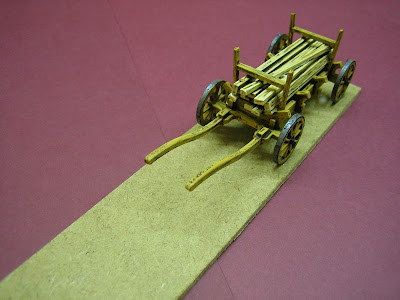Although I eventually intend to have enough war game pieces to represent all of the combatant formations (though not fielded altogether, you understand) I decided to start by buying enough stuff to field the British and the Germans. I used Battlefront's Flames of War range for almost everything. I put in one big order and bought everything at once, obtaining a 40% trader discount in the process (the photo opposite shows about 70% of it).
As I plan on fighting battles with 'brigade group' sized battle groups, I decided to use the OOB, in Frank Chadwick's excellent Benghazi Handicap. This book scales the forces at roughly 1:5 - or one stand to a platoon / troop. This scale allows quite big all arms actions to be carried out on a good sized table.
Looking at the breakdown of Afrika Korps, the obvious formation to use as the base for all of the forces was 15th Panzer Division. This formation can be converted into the major elements of 21st Panzer, or Afrika Division ZBV, quite easily. I still have a few pieces, to convert 15th Panzer Division into Afrika Division ZBV, to do (namely 605th PzJager Btn and some Anti Aircraft pieces) but otherwise, this is (less some basing to finish) the German collection completed. I'll never be able to use all of it at the same time but, I will be able to use big chunks of it at the same time.
8th Panzer Regiment.
Two battalions of three companies (two light, one medium); two battalion command elements and a regimental command element (round bases); an attached Luftwaffe heavy AA battery (8.8cm).
33rd Reconnaissance Battalion.
A company of armoured cars; a motorcycle company (mounted / dismounted); a support company; a battalion command element.
Dedicated transport is pictured.
115th Rifle Regiment.
Regimental command element and regimental support elements (AT and infantry gun); 2 infantry battalions each of: 3 companies of infantry; a support company; a battalion command element.
Dedicated transport is pictured.
200th Infantry Regiment.
Regimental command element and SP infantry gun company.
15th Motorcycle Battalion: 3 infantry companies; a support company; battalion command element.
2nd Machine Gun Battalion: 3 MMG companies; a support company; battalion command element.
Dedicated transport is pictured.
Artillery.
33rd Artillery Regiment: General Support battalion of 3 15cm howitzer batteries; 2 Direct Support battalions each of 3 10.5cm howitzer batteries; 3 forward artillery observer (FAO) elements.
33rd Artillery Battalion: 3 companies each of 2 3.7cm and 1 5cm AT gun.
Dedicated transport is pictured.
Note: There are no command elements as these guns were either generally attached to other formations or they can use their FAO element.
33rd Pioneer Battalion: 2 companies of infantry.
Dedicated transport is pictured.
Note: There is no command element as these companies were either generally attached to other formations.
Non dedicated transport pieces: 24 Motor Transport stands.
My favourite AFV piece is the Sdkfz 121/122 self propelled 15cm infantry gun on Pz II chassis.
My favourite piece of artillery is the 8.8cm. I've liked the look of this powerful gun since childhood.
My favourite motor transport pieces are the motorcycle combinations - especially en masse.
Each of my national forces will have an ambulance. To get them onto the table they will be used as command elements.
The most bizarre (pointless) piece is the enormous Sdkfz 9 tractor. It will be used as a transport piece just to get it on the table from time to time.
Speaking of 'pointless', I have omitted non-teeth arms from my order of battle. Not because I don't see why they were important but, rather because they have very little use on a wargame table.
Will I buy any more Germans? Yes, I still need two 2cm AA guns plus dedicated transport, half a dozen more Opel Blitz trucks and three SdKfz 7s for the 15cm hows. These were unavailable when I ordered all this stuff back in August 2010 - I'll get round to buying them eventually, probably with the Italian stuff I'll need.
I'll be concentrating on the British next. Although I've made a very good start (50%?) on the British, I still have quite a lot of armour, infantry and artillery to paint. In fact, the stuff to paint for the British outweighs the Germans by a considerable amount. There are 25 tanks in the German force, there are over 100 in the British force - including Crusader I, A9, A10, A13, Honey, Matilda, Valentine and even some Vickers VI (for the infantry division's cavalry regiments).
Anyway, I hope you like the results of the very slow effort so far. For my part, I'm quite pleased with the way things have turned out and finishing a major part of any collection is always a spur to get the rest done. Thing is, this is my 'non-project' that I use as a change of menu when I get bored of painting 28mm; it may be some time before this particular cog turns again - especially as the next job is basing, uuuuurgh.





























